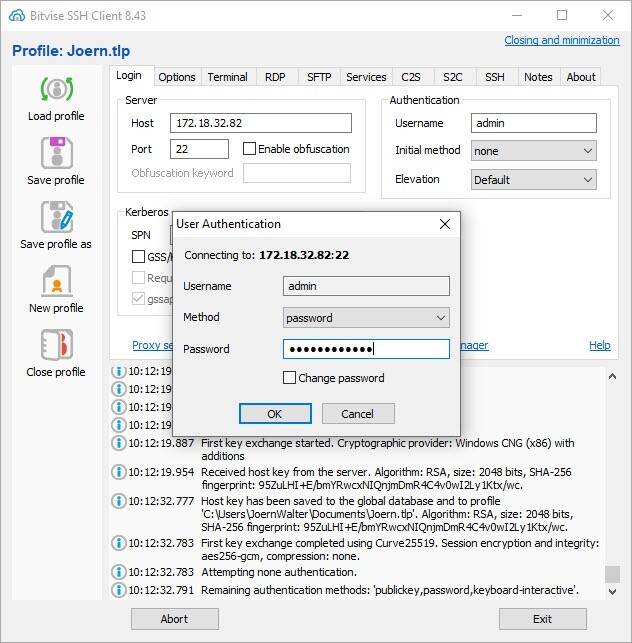
- #OPENSSH WINDOWS SERVER 2012 INSTALL#
- #OPENSSH WINDOWS SERVER 2012 WINDOWS 10#
- #OPENSSH WINDOWS SERVER 2012 DOWNLOAD#
- #OPENSSH WINDOWS SERVER 2012 FREE#
Once connected, you should get a new, clean command prompt. Simply ensure you use the format when prompted for the username. The connection process requires you to accept the remote server's SSH Server key and then enter your password.Īlternately, you can use any SSH client to connect such as PuTTY. Once that's done, connect with the command: ssh example, to connect to a server named cntsapp01 as adminuser on the domain, use: ssh I'm connecting as the user da_mgrande in the domain MGLAB.
#OPENSSH WINDOWS SERVER 2012 INSTALL#
If you want to use the built-in OpenSSH client software in Windows 10, you can install it with this command: Add-WindowsCapability -Online -Name OpenSSH.Client~~~~0.0.1.0 Wasn’t that easy! To test, try connecting to the server from your workstation using SSH. Now, you should have a basic, working SSH service running on your server.

Set-Service ssh-agent -StartupType Automatic Again, run these in PowerShell as administrator: Set-Service sshd -StartupType Automatic By default, these services are not enabled or started up. Once the installation succeeds, the Windows services need to be configured for automatic start and started up. That should be run in a PowerShell window as administrator. The first step is to install the SSH component using the command: Add-WindowsCapability -Online -Name OpenSSH.Server~~~~0.0.1.0 Additionally, if you have a mixed Linux/Windows environment, using SSH would allow for a more uniform experience across the platforms. You also have the option of setting the default SSH shell to PowerShell as opposed to CMD.Īlthough installing and configuring SSH may not benefit a traditional Windows admin too much, it would be very useful in an environment where you're running Windows Server without a GUI. The configuration of the SSH Server feature entails installing the capability and enabling the services.
#OPENSSH WINDOWS SERVER 2012 WINDOWS 10#
This feature was originally introduced with the 1804 release of Windows 10 and has since been added into Windows Server 2019.

If you need to add some package afterwards, simply re-run setup.exe installer and check additional packages that you want to install.New to Windows Server 2019 is the OpenSSH Client and Server capability that can be enabled with PowerShell. If service doesn’t start check the log at C:\cygwin\var\log\sshd.log. Open cmd.exe with “Run as admninistrator”: I’m not sure what is the true reasoning for that, but probably for hardening the sshd security!? Or within cygwin.bat: nano /etc/sshd_configĪt the end of file add: KexAlgorithms diffie-hellman-group-exchange-sha1,diffie-hellman-group1-sha1 $ /bin/mkpasswd -d -u alesk > /etc/passwdĢ.5) Edit ssh config file: notepad C:\cygwin\etc\sshd_config It means that you can connect to ACMEHOST from some remote workstation with: $ ssh cool. You’ll probably find numerous recommendation on the net (and even in Oracle documentation - “Enterprise Manager Cloud Control Basic Installation Guide”) that first thing you should do is to open cygwin.bat and insert line set CYGWIN=binmode ntsec, so that bat would look like: notepad off Run the installer and follow the wizard, here are screenshots from my host: More precisely, I selected the following packages and their dependencies: nano, zip, unzip, OpenSSH, openssl and rlwrap. I downloaded 64-bit version because I’ll be installing 64-bit packages.
#OPENSSH WINDOWS SERVER 2012 DOWNLOAD#
I decided that I’ll try to use SSHD from directly, something that I tried to avoid in the last decade.įirst you’ll need to download installer from, save the file in some temporary directory.
#OPENSSH WINDOWS SERVER 2012 FREE#
This time around I needed a free SSH server for Windows 2012R2 host without the limits imposed by recent CopSSH free version. Whenever I need some Cygwin functionality on my Windows hosts, I always prefer pre-packaged solutions ( Mobaxterm for ssh client on Windows, CopSSH for SSHD, etc.).


 0 kommentar(er)
0 kommentar(er)
